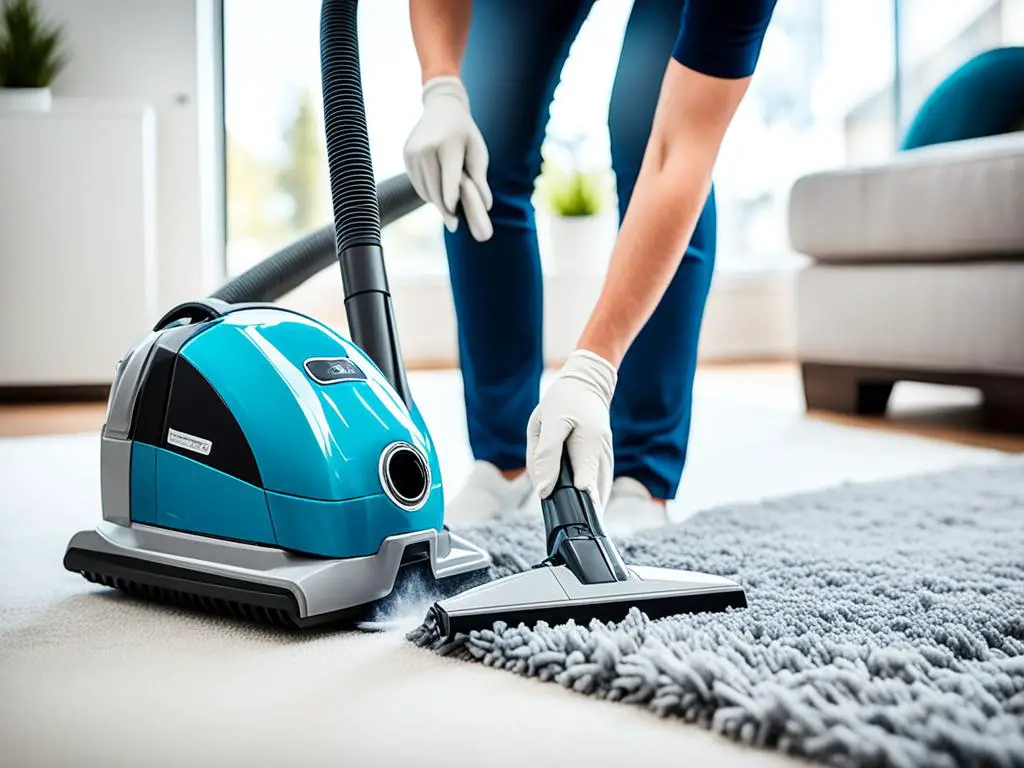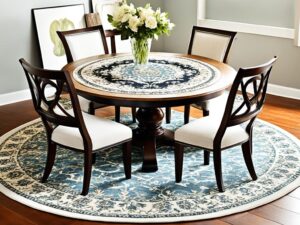Viscose rugs can add a touch of elegance to any space with their soft sheen and luxurious feel. However, they require special care when it comes to cleaning. Unlike other rugs, viscose rugs are sensitive to water and can lose their shape or develop stains when exposed to moisture. That’s why it’s important to know the best methods for cleaning and maintaining these delicate rugs.
Key Takeaways:
- Regular maintenance of a viscose rug includes vacuuming and gentle brushing to remove dirt and keep the fibers soft.
- Household remedies such as water, dishwashing detergent, clear glass cleaner, and white wine vinegar can be used to treat stubborn soiling on viscose rugs.
- Special cleaning agents for stained viscose rugs are available in stores.
- Professional cleaning by a specialist may be necessary for heavily soiled or stained viscose rugs.
- Avoid using water or excessive moisture when cleaning a viscose rug to prevent damage.
Why Viscose is Not a Suitable Fiber for Rugs or Carpet
Viscose rugs, also known as rayon or art silk rugs, have gained popularity due to their beautiful soft sheen that resembles silk. However, it is important to understand the limitations and weaknesses of viscose fiber when considering it for rugs or carpet.
Viscose is a man-made fiber derived from natural sources such as wood, cotton, or bamboo. Although it shares some qualities with silk, it falls short in terms of durability and performance. The weakness of viscose fiber becomes evident when it comes to everyday use and maintenance.
One of the major issues with viscose rugs is shedding. The fibers tend to come loose and shed, especially in high-traffic areas. This can result in a rug that looks worn out and lacks aesthetic appeal.
Color runs are another concern with viscose rugs. When exposed to liquids, such as during cleaning or in the event of a spill, the colors in the rug can bleed or run. This can lead to irreversible damage and the loss of the rug’s original beauty.
Cellulose browning is yet another common problem with viscose rugs. The cellulose fibers in viscose can react to moisture, causing browning or yellowing of the rug. This can happen even with minimal exposure to water, making it challenging to clean without causing further damage.
Matting and crushing are additional weaknesses of viscose rugs. The fibers can quickly become flattened and matted, losing their softness and leaving the rug looking dull and lifeless.
Overall, the limitations of viscose fiber make it an unsuitable choice for rugs or carpet that are subjected to regular foot traffic and potential spills. Extra care and caution must be taken to prevent shedding, color runs, cellulose browning, and matting from occurring.
The Weaknesses of Viscose Fiber:
- Shedding in viscose rugs
- Color runs in viscose rugs
- Cellulose browning in viscose rugs
- Matting and crushing in viscose rugs
Viscose is a weak fiber that does not stand up well to foot traffic. It is prone to shedding, color runs, cellulose browning, and matting.
How to Protect and Care for Your Viscose Rug
Proper protection and care are essential to maintain the beauty and longevity of your viscose rug. Follow these tips to ensure your rug stays clean, soft, and free from damage.
Apply Fabric Protector
Immediately after purchasing your viscose rug, it is crucial to apply a fabric protector. To achieve optimal results, it is recommended to hire a professional cleaning company for this task. Multiple light applications may be necessary, allowing each coat to dry before applying the next.
Dry Vacuum Regularly
Dry vacuuming your viscose rug on a regular basis is an effective way to remove dirt and maintain its softness. However, it is important to use caution and avoid using strong suction or beater bars that can damage the delicate fibers.
Prevent Moisture Damage
Moisture can cause significant damage to viscose rugs, so it is vital to take precautions to prevent moisture-related issues. Avoid placing moist objects directly on the rug and be mindful of spills and excessive humidity. In the event of a spill, take immediate action by blotting it with a clean white cotton towel or sponge. For stubborn stains, create a mixture of water and white vinegar and gently apply it to the affected area. It is important to avoid using spot removers, as they can cause more harm than good. Allow the rug to air dry, placing a weighted towel over the damp area to help absorb excess moisture.
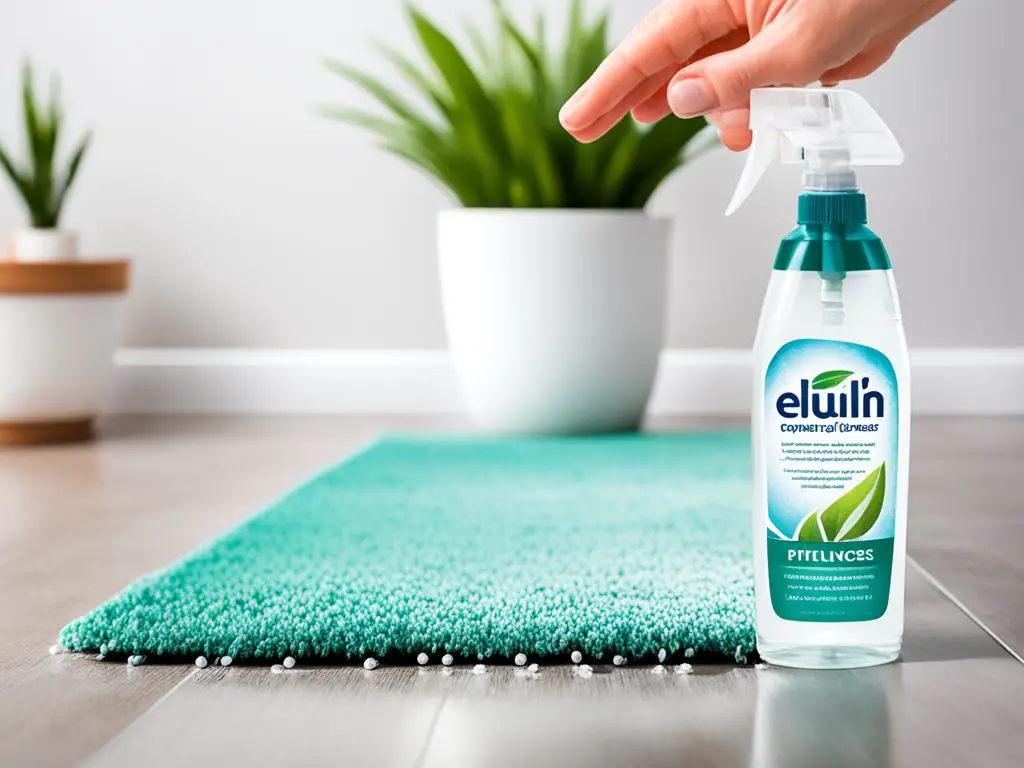
- Apply fabric protector after purchase
- Dry vacuum regularly with appropriate settings
- Avoid placing moist objects directly on the rug
- Blot spills immediately with a clean white cloth or sponge
- Treat stubborn stains with a mixture of water and white vinegar
- Air dry the rug, placing a weighted towel over damp areas
By following these care and protection guidelines, you can enjoy the beauty of your viscose rug for years to come.
Knowing Your Viscose Rug
Understanding the characteristics of your viscose rug is essential for proper maintenance. Each rug may have unique color variations and patterns due to dye lots, adding a touch of individuality to your space.
Rug shedding is a common characteristic of viscose rugs, especially when they are new. However, regular vacuuming can help minimize shedding over time, keeping your rug looking its best.
Upon arrival, your viscose rug may have temporary creases from being tightly rolled during shipping. To relax these creases, gently reverse roll the rug and allow it to settle in its natural form.
Sprouts, or loose fibers, may appear on the surface of your viscose rug. These can be easily managed by trimming them to the same height as the rest of the pile, preventing further shedding.
Excessive exposure to sunlight can result in fading of the rug’s colors. To preserve its vibrancy, it is important to place the rug away from direct sunlight or use window coverings to filter out harmful UV rays.
Humidity can have a negative effect on viscose rugs, causing them to yellow or brown. Avoid placing the rug in areas with high humidity or direct moisture contact to prevent these issues.
Regular rotation of the rug and the use of furniture pads can help distribute wear and prevent furniture marks on your viscose rug. This ensures that the rug maintains its beauty and prolongs its lifespan.
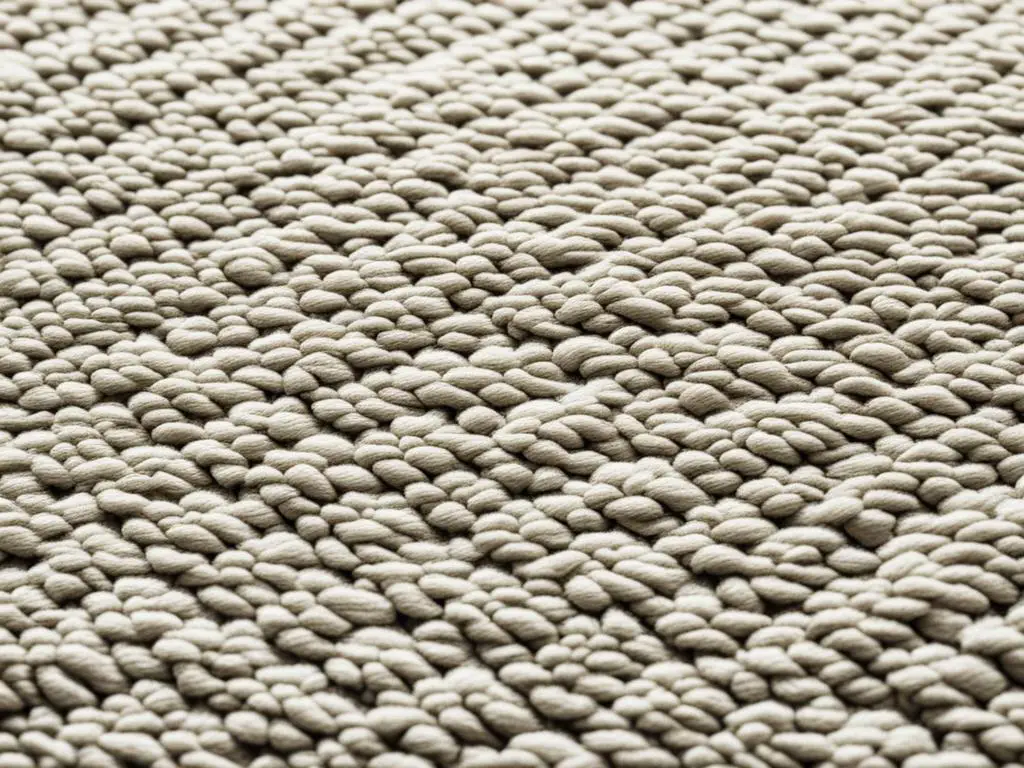
| Characteristic | Description |
|---|---|
| Color Variations | Each rug may have unique color variations due to dye lots. |
| Rug Shedding | Viscose rugs tend to shed, especially when new. Regular vacuuming can help reduce shedding. |
| Creases | Temporary creases may occur upon arrival and can be relaxed by reverse rolling the rug. |
| Sprouts | Loose fibers, known as sprouts, may appear and should be trimmed to prevent shedding. |
| Fading | Exposure to sunlight can cause fading in viscose rugs. Protect the rug from direct sunlight. |
| Humidity Effects | High humidity can cause yellowing or browning of viscose rugs. Avoid direct moisture contact. |
| Wear and Furniture Marks | Regular rotation and the use of furniture pads can prevent wear and furniture marks on the rug. |
Cleaning Instructions for Viscose Rugs
When it comes to cleaning a viscose rug, it is important to follow safe methods that avoid water or excessive moisture. Proper cleaning techniques will help maintain the rug’s appearance and prolong its lifespan. Here are some essential cleaning instructions for viscose rugs:
Vacuuming Viscose Rugs
Vacuuming regularly is crucial for keeping viscose rugs clean and preventing excessive shedding. Use a vacuum cleaner suitable for viscose and wool carpets to gently remove dirt and debris without causing damage. Avoid using strong suction or beater bars that can pull or snag the delicate fibers.
Cleaning Spills on Viscose Rugs
Accidents happen, and spills on viscose rugs should be addressed immediately to prevent staining. Take the following steps to clean up spills effectively:
- Blot the spill with a clean, dry cloth to absorb as much liquid as possible. Avoid rubbing, as it can push the spill deeper into the fibers.
- If the spill persists, mix a small amount of mild dishwashing detergent with cold water.
- Gently dab the soapy solution onto the spill, working from the outer edges towards the center.
- Blot the area with a clean, dry cloth to remove the detergent, ensuring the rug is not left damp.
It is important to test any cleaning solution on an inconspicuous spot of the rug first to ensure it doesn’t cause discoloration or damage.
Professional Cleaning for Viscose Rugs
In some cases, professional cleaning for viscose rugs may be necessary, especially for deeply stained or heavily soiled rugs. Professional cleaners have the expertise and specialized equipment to effectively clean and restore the rug’s appearance. Consider consulting a professional cleaner for safe and thorough cleaning of your valuable viscose rug.
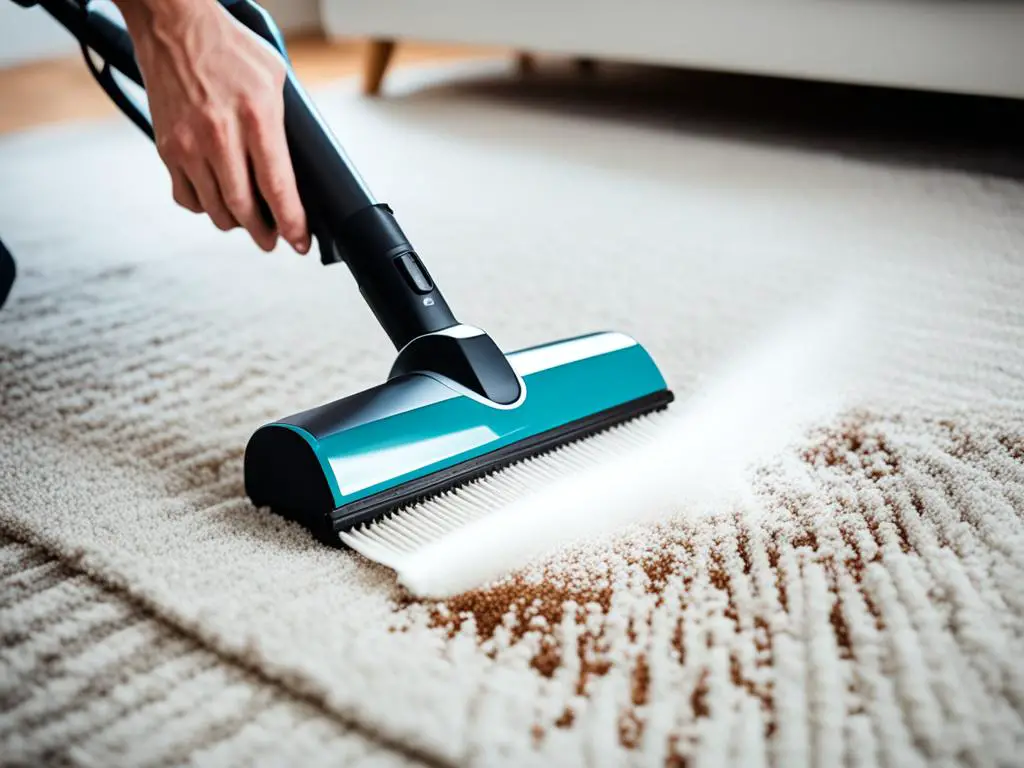
| Cleaning Methods | Advantages | Disadvantages |
|---|---|---|
| Regular Vacuuming | – Removes dirt and debris – Helps prevent shedding |
– Cannot remove deep stains |
| Spill Cleanup | – Addresses spills immediately – Prevents staining |
– May not work on stubborn stains – Requires caution to avoid pushing spills deeper into the fibers |
| Professional Cleaning | – Expertise and specialized equipment – Thorough cleaning and restoration |
– Costly – Requires professional assistance |
Cleaning Instructions for Wool Rugs
Wool rugs are a popular choice for their durability and resistance to spills, but they still require special care to maintain their beauty and longevity. To keep your wool rug in excellent condition, follow these cleaning instructions:
Vacuum regularly: Vacuuming your wool rug at least twice a month will help prevent shedding and remove dirt and dust that can accumulate over time. Use a vacuum cleaner with a brush attachment or a vacuum specifically designed for wool carpets to avoid damaging the fibers.
Blot liquid spills: Accidents happen, but it’s important to act quickly when a liquid spill occurs on your wool rug. Grab a clean, dry cloth and gently blot the spill to absorb as much liquid as possible. Avoid rubbing or scrubbing, as this can push the liquid deeper into the fibers.
Treat stains: If a stain remains after blotting a liquid spill, you can use a mild solution of dishwashing detergent and cold water to remove it. Mix a few drops of detergent with water and dab the stained area with a clean cloth. Be sure to test the solution on a small, inconspicuous area of the rug first to ensure it doesn’t cause any discoloration.
Professional cleaning: While regular maintenance is essential, professional cleaning once a year is recommended for wool rugs, especially if they experience heavy use or have stubborn stains. Professional cleaners have the expertise and equipment to deep clean your wool rug without causing damage.
By following these cleaning instructions, you can keep your wool rug looking its best and prolong its lifespan. Remember to take preventive measures, such as placing doormats at entrances and avoiding shoes on the rug, to reduce the amount of dirt and debris that accumulates.
Testimonial:
“I’ve always admired the warmth and texture that wool rugs add to a room, but I was hesitant to invest in one because I wasn’t sure how to clean it properly. These cleaning instructions for wool rugs have been a game-changer for me! I now feel confident in maintaining my wool rug’s beauty and keeping it in pristine condition. Thank you!” – Sarah, happy rug owner
Cleaning Instructions for Silk Rugs
Silk rugs are known for their delicate fibers, requiring special care and attention to maintain their beauty and integrity. Follow these cleaning instructions to ensure the longevity of your silk rug:
Vacuuming Silk Rugs
Regular vacuuming is essential to remove dust and debris from silk rugs. Use a vacuum cleaner with a brushless suction head to avoid damaging the delicate fibers. Gently glide the vacuum in the direction of the pile to pick up any loose particles without pulling or snagging the silk threads.
Spot Cleaning Silk Rugs
Accidents happen, and if your silk rug experiences a liquid spill, it’s crucial to address it promptly. Immediately blot the spill with a clean, dry cloth to absorb as much liquid as possible. Avoid rubbing or scrubbing, as it can push the spill deeper into the fibers or cause the stain to spread. If necessary, a mild detergent diluted in water can be used to gently dab the affected area. Test the detergent on an inconspicuous spot first to ensure it doesn’t cause any damage or discoloration.
Professional Cleaning for Silk Rugs
While regular vacuuming and spot cleaning help maintain silk rugs, professional cleaning is recommended periodically to remove deep-seated dirt and grime. Professional cleaners have the expertise and specialized equipment to safely and effectively clean silk rugs without causing any harm. They use techniques tailored to silk fibers and can restore the rug’s luster. Consider professional cleaning every one to two years, depending on the rug’s condition and usage.
By following these cleaning instructions, you can enjoy the beauty of your silk rug for years to come. Remember to practice preventive measures, such as placing a rug pad underneath to minimize slipping and rotating the rug occasionally to distribute wear evenly.
Conclusion
Viscose rugs require special care and attention to keep them clean and beautiful. Due to their sensitivity to water and other traditional cleaning methods, it is important to adopt alternative cleaning techniques. Regular vacuuming is crucial to remove dirt and prevent excessive shedding. Immediate cleanup of spills and stains is essential to prevent permanent damage.
When it comes to cleaning a viscose rug, it is advisable to use household remedies such as water, dishwashing detergent, clear glass cleaner, or white wine vinegar for treating stubborn soiling. However, it is always recommended to test these solutions on an inconspicuous spot first. In cases where stains are deeply embedded or the rug is heavily soiled, seeking professional cleaning services from a specialist is the best option.
By following these tips and guidelines, you can maintain the elegance and beauty of your viscose rug for years to come. Remember, regular maintenance and proper care are key to preserving the delicate fibers of your rug. Whether it’s vacuuming, spot cleaning, or seeking professional services, these steps will ensure that your viscose rug remains in optimal condition, allowing you to enjoy its luxurious feel and captivating beauty.
